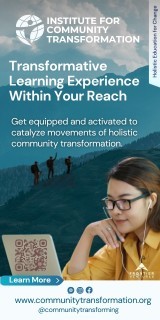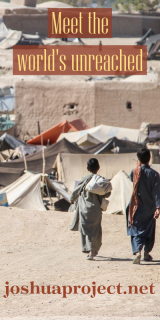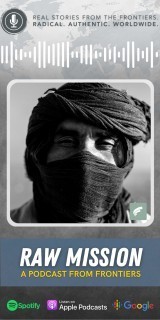Reviving the Church’s Vision for the Final Frontiers
Perspectives on the World Christian Movement

"In a way that I never imagined, God has called me to preach the Gospel on every continent and many countries around the world. But I know that the on-going work of evangelizing the world, especially the unreached people groups where there are presently no church or witness, is a primary responsibility of Christians everywhere. There is no volume of which I know that will inform, inspire, and motivate Christians for world evangelization like the Perspectives course. It is written by some of the leading missiologists and missionaries of the world. It will stretch your mind, warm your heart, and stir your will." -- Billy Graham
Over 22,000 people have completed the Perspectives study program and as a result have impacted churches and unreached peoples world-wide. The nature of the course is the primary reason of its hard-hitting effect. Perspectives is not simply an academic course designed to help mission-minded folks learn more about missions. Rather, this course has helped open the eyes of people from all walks of life to what God is doing globally.
Most Americans know very little about God's work in the world. In fact, it's difficult no matter where you live to know about the world Christian movement as such news is not readily available. Certainly the Los Angeles Times, National Public Radio or even Dateline would not carry this information. But you can discover this exciting news in the appropriately named course, Perspectives on the World Christian Movement.
This program, which examines four major concerns or perspectives is brought to life by the speakers. Each class offers new insight with a different top missions leader and thinker. These teachers offer insight on their area of expertise as well as practical resources for further exploration.
The first perspective explored in the course is the Biblical basis for missions. The entire Bible is carefully examined to reveal God's heart for the nations and His desire for their redemption.
Secondly, the study of the historical expansion of the Christian movement from the time of Christ gives us a new perspective on how to win entire people groups today.
Third, the class explores culture and how it impacts the way the gospel is presented to other peoples. Two critical issues are how to make the gospel relevant to the listeners and how to reach the people without imposing the missionary's own culture.
The last perspective focuses on the strategic considerations: effective use of finances and personnel, mobilization of other Christians, discipleship and personal involvement in accomplishing God's plan for world evangelization. This perspective is perhaps the most important as it directly addresses completing God's command to reach all peoples with the good news of Jesus.
To give you an idea of a typical Perspectives class, listed below are the lessons, in order.
Biblical:
1.) The Living God is a Missionary God, 2.) The Obligation and the Opportunity, 3.) The Kingdom Strikes Back, 4.) A Man and a Message for all Peoples;
Historical:
5.) The Expansion of the Christian Movement, 6.) Eras of Mission History & Pioneers of the World Christian Movement;
Strategic:
7.) The Task Remaining, 8.) Strategy for World Evangelization & That Everyone May Hear;
Cultural:
9.) A World of Difference & How Shall They Hear, 10.) Building Bridges of Love, 11.) The Church and Culture;
Strategic II:
12.) The Spontaneous Multiplication of Churches, 13.) Pioneer Church Planting, 14.) The Unreached Peoples and the Hungry Half, 15.) World Christian Teamwork & World Christian Discipleship.
How it all began —
By now the question arises of just how Perspectives got its start. To answer that requires us to go back a few years...
As a student, Ralph Winter had attended the first "Urbana" student mission convention (held at Toronto that first year) in 1946. Increasing annually from 1,000 that first year to over 10,000 students in 1970, student interest in missions was quickened. But during the 1960s their commitment to missions sagged.
Suddenly, however, in 1973 that trend seemed to reverse when 28% of the students attending the Urbana Student Missionary Convention committed themselves to be missionaries if God so desired--a big leap from 8% at the previous convention in 1970!
Three weeks after this sudden reversal, in January of 1974, Winter, then a professor at the Fuller School of World Mission, became concerned that when these zealous young people returned to their campuses and homes, they would lose their commitment for lack of any further understanding of missions. He also wondered if this shift might indicate the beginnings of another student missions movement. Would it die because the Church had no way to educate and mobilize these young people?
He talked to InterVarsity --which had never released the names and addresses of those signing the commitment cards. He met with a group of Wheaton mission executives, along with David Howard who represented IVCF, then decided to go ahead with a "Summer Institute of International Studies" the coming summer.
The next months were busy ones for Winter and his two college-age daughters, who before 8 a.m. each morning called Urbana commitment signers, inviting them to this new missions course.Thirty came for nine weeks to Wheaton College in Wheaton, IL. The course was not easy; indeed they received 4 units of credit, transferable even to secular schools. Thus, what is now called the Perspectives Study Program was born.
Because it was too late to get any professor for the entire summer, Dr. Winter asked for one week only from a number. This pattern of exposing the students to many experienced missionary professors and executives proved to be so effective that it has been followed since then, with each professor presently teaching only one three-hour session. Besides what they learned in class, the daily contact through prayer, exercise and over the meal table with well known missionary greats literally changed the lives of those students.
The second summer, many of those early alumni returned, bringing others with them. Two brought ten each, and a couple from Boston led a caravan of 20 students. Within a few years, with the cooperation of Campus Crusade, Navigators and InterVarsity, the enrollment jumped to 250! Then, problems arose because one or two on the board thought it might be best to not grow so quickly but rather to set up a model program of just a few students. Their influence on the board and enrollment was like water on fire. Within two years, enrollment had fallen to 50, then 25. By 1977, there were only 15 students registered, and it appeared that the class would have to be cancelled due to costs.
For several years, Dr. Winter had deliberately kept hands off. Now, that the course seemed on the verge of expiring, he offered to once again shoulder the responsibility and moved the class to the newly founded US Center for World Mission (USCWM) campus in Pasadena, CA. Once again, the IIS alumni who had joined Winter there took charge of student recruitment, and in four weeks had 35, a sufficient number to break even. Within a few years the course began to be offered both in the spring and fall, and the name was changed to the Institute of International Studies (IIS), dropping the word "Summer." The course load was also modified to grant 3 units of transferable college or seminary credit and audit possibilities to those who did not want the units.
The question remained, however, of how to get this powerful program to students and others who could not afford to leave their classes or work to come to California for a semester. What about taking the class to them? By 1979, it had been taught in several places, Erskin College, U of Colo. at Boulder, etc. In 1980 Jay and Olgy Gary coordinated the first official extension course at the University of Pennsylvania.
By 1981, the outside readings for the class were gathered in book form with the help of Steve Hawthorne and others. And in 1983, workshops to train coordinators began on the Center campus. Finally, in 1986, the name IIS changed to Perspectives on the World Christian Movement.
Since the name change, the work of the Perspectives office at the USCWM has expanded to more than 80 teaching locations annually around the world. Coordinators in these extension locations line up teachers and train new coordinators for other locations as well as help Perspectives alumni find ways to put their knowledge into practice.
The outstanding feature of the Coordinator workshops and Perspectives classes is that they no longer just attract students. Missions pastors, retired persons, and active lay persons now participate as well.
As larger numbers of people take the Perspectives course and then share their experience with others, the classes are seeing steady growth and the extension offices are having to expand in response.
The Impact --
"After being an Alliance missionary for 26 years, I should have known (the course content), but the course helped me ... to get it all into perspective--the how and why of the expansion of God's Kingdom and where I fit in."--Evangeline Davidson, missionary
More than 22,000 people have taken the Perspectives course under the supervision of the USCWM as well as thousands more overseas. To date,100,000 copies of the texts are in print, many used each year by seminaries and Bible Schools.
The main test of this course's impact, however, is the lasting effect it has on the participants' lives. To get a glimmer of this, a survey was sent to 200 randomly selected students. Here are some of the results from the 86 percent who responded.
Increased Understanding:
Of the 53 % who began Perspectives with minimal or no understanding of missions, 90% left with a good or exceptional understanding.
Of the 21% who started with a good understanding,, 96% left with a better or excellent understanding.
New Commitments:
Of the 53% who began their course with minimal or no understanding of missions, 80% are now strongly committed to missions.
Of those 21% beginning with a good understanding of missions, 91% are now strongly committed to missions.
Influenced Careers:
Overall, 64% of the respondents were at least partially influenced in career decisions while 41% were strongly or substantially influenced.
Long-term Plans:
At least 66% of the participants plan on long-term (two or more years) cross-cultural missions involvement.
What Now?
Obviously, Perspectives has a profound effect on those who take the course. Many have likened it to a compass that helps in discerning God's direction for their lives. Certainly, the more fully we grasp His unchanging purpose throughout history, the more fully we can understand His will.
Just as no serious runner would begin a marathon without knowing the layout of the course, no Christian should make serious long-term plans without first seeking God's direction.
Although Perspectives cannot tell you what path your life should take, it can show you God's over-all purpose for mankind and then give you the resources to make an informed decision about how to fit into God's plan.
If you are interested in taking a Perspectives class in your area please see the class list for the upcoming term on pages 15-16.
If you are one of the 22,000 who have taken Perspectives, tell a friend to take it this year. Word of mouth is a powerful tool in spreading the vision.
If you would like more information about Perspectives, please write or call our office here in Pasadena or the Regional Office of the US Center in your area. See the list of Regional Offices on page 44. You may contact the Pasadena Perspectives office by writing
Perspectives Study Program
US Center for World Mission
1605 Elizabeth St.
Pasadena CA 91104
or call 818-398-2125
How Can You Be Involved In Missions?
165 Perspectives Alumni classify their current missions involvement:
88% support missions work financially
74% read missions periodicals or books
73% have a regular prayer time for missionaries
42% are currently involved in cross-cultural outreach
36% are preparing for cross-cultural work
29% serve on a church missions committee
28% are involved with a mission agency
27% find frequent opportunity to share about frontier missions
25% are part of a missions prayer group
11% have signed the Caleb pledge to commit their lives to the Great Commission







comments